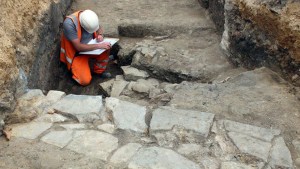Lenten Campaign 2025
This content is free of charge, as are all our articles.
Support us with a donation that is tax-deductible and enable us to continue to reach millions of readers.
The Anchor Church Caves of Derbyshire, England, have been identified as the dwelling of a 9th-century saint. Originally believed to be part of an 18th-century aristocratic summer home, the caves’ history appears to be much richer than originally thought. Now, experts say one cave was once home to St. Hardulph, a hermit saint who was once King of Northumbria.
A detailed survey described the cave as a “small, intimate space,” made up of three chambers and a chapel. According to CNN, the Anglo Saxon cave house was dated to the 9th century based on its architecture and references from a medieval manuscript. This dating makes it likely that the cave was once the hermitage of King Eardwulf of Northumbria, also known as St. Hardulph.
St. Hardulph
Little is known about the life of St. Hardulph, besides that he was a deposed king who lived as a hermit. The Anchor Church Caves actually derive their name from their use as a hermitage. “Anchor,” or “to withdraw,” is a Greek term, and the word anchorite is often used as a term similar to hermit, as both describe the eremitic life. St. Hardulph, for whom a nearby church is named, died in 830 and was buried just five miles from the caves.
In an interview with CNN, Edmund Simons, a research fellow at the RAU, said of the site’s significance:
While there are a few churches with intact interiors that date from a similar period, Simons said, “there’s nowhere else really where you can walk into somewhere where somebody ate and slept and prayed and lived.”
The report notes the the cave is not exactly as it would have been in St. Hardulph’s time. In the 18th century, the aristocratic family that owns the site conducted renovations that widened doors and added window frames. It is possible that these factors contributed to the site’s incorrect dating for so long.
Watch the video, featured above, to see the Anchor Church Caves as they are today.

